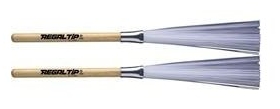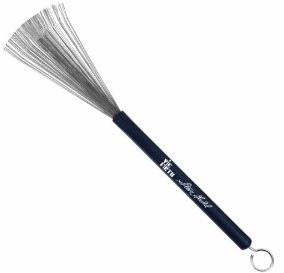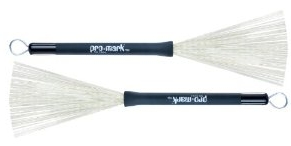I'll start with the Regal Tip 551WXL model. This model is but one of many that I have accumulated, and by rights should not appeal to me because I prefer smaller diameter handles on brushes and sticks. However, appeal to me it does.

While most of my brushes and sticks sport handles in the .5" diameter range, this one has a whopping .562" diameter handle. At first it was uncomfortable and I almost tossed it into my little closet of horrors - purchases I tend to make that seemed like a good idea at the time. Instead, I lazily left them in my practice room, and started using them. While I am not sold on them, I have grown to appreciate certain aspects. They are extremely well balanced and actually feel good when playing ballads. I love the wires, which - again - seem well suited to ballad work. Considering the size of the handle that may be counter-intuitive to many folks.
If you play Latin or Brazilian, the Regal Tip 565U Ultraflex is a good choice.

This and the Regal Tip BR-594P Ed Thigpen Plastic Brushes are two brush models that every drum kit player who plays Latin and Brazilian should have in their stick bag.
Where the Ed Thigpen model can work for playing fast, staccato notes while implying a cabasa with one of the brushes, this model will provide a different set of textures. Specifically, the large, nylon brush area can be used to create patterns that work with Latin and Brazilian music from a drum kit player's perspective.
If you have read the preceding two parts and have read to this point here you may have noticed that I prefer Regal Tip brand brushes. I personally think that they make the best brushes on the market. The key word is personally. In fact, I do own some models from other brands and will wrap this up by discussing those.
The Vic Firth Heritage model is a popular brush that many drummers use.

This particular brush is a safe choice if you are looking for a first pair to learn the art of brush playing. I like the feel of the wire bristles, which have good flex and a relatively tight fan that makes it an excellent choice for general purpose playing (for softer ballads I prefer a brush with a wider fan when fully opened.)
Handles are light with sufficient balance that they will not fatigue you on a brush-only gig. I love the triangle-shaped ends on the retractable handles, which allow you to use the apex for zings around the lathed tonal grooves of cymbals.
Personally, I am not too fond of how the retractable handle seems to lock into position when the wires are fully fanned, but does not hold when the wires are fanned in any other spread. For my personal playing style I adjust the wire fan to achieve the dynamic level appropriate for each song, as well as to achieve the staccato or legato level I want. Unfortunately, these brushes do not support my playing style. They may, however, be perfect for you since brushwork is probably the most personalized technique in drumming.
The Vic Firth Steve Gadd Signature Brush is an interesting design that I feel falls short of its stated design goals, but turns out to be perfect for a different application.

This brush is advertised as being ideal for preventing brush wires from catching on new, coated drum heads. The design feature that allows that is a bend at the ends of the bristles. Frankly, that idea makes no sense because you can very lightly run 400 grit over a new, coated head and immediately break the head in for brush playing. Another problem with the intended use is once a head was broken in by the bent bristles, it starts to wear very quickly - a double whammy!
On the other hand, this brush is perfect for calf heads or heads designed to simulate calf, such as the Remo Skyntone head that I use on some of my snare drums, or my alternate choice, the Remo Fiberskyn. Those heads have a very subtle, calf skin like texture (the Skyntone even simulates pore holes) that are good for ballads with regular brushes, but sometimes too subtle for other styles. These brushes, though, are perfect for those heads.
I have also tried these brushes out on Remo Renaissance heads with excellent results.
The balance and feel are not the same as my much preferred RegalTip brushes (every model I've used seems to have great balance and feel), but that is a personal preference. You may wind up loving they way these feel. I have a few snare drums outfitted with calf, Skyntone and Fiberskyn heads, so I always keep a pair of these brushes in one of my stick bags. For those heads these are perfect.
And last, but not least, the Pro Mark TB6 retractable model will wrap up this entire series on brush models.

I purchased a pair of these brushes when they were on sale to check them out. I am normally a loyal RegapTip brush fan, but I do have a few other brands. I'll compare this pair to its closes competitors:
Compared to the RegalTip 596R Jeff Hamilton Brushes this pair is slightly lighter than the Jeff Hamilton model, and does not have the same weight. However, the diameter and length are fairly close. Also, while the Jeff Hamilton model has heavy wires, this one has heavier wires. I use the Jeff Hamilton brushes occasionally (depending on which stick bag I grab) and despite the differences, in a live playing situation I doubt you would know the difference once you started concentrating on the music.
It stacks up better against a popular model, the Vic Firth Heritage model (in my opinion). I prefer the feel and balance of the Pro-Mark over that one, and I think the wires sweep and tap better. They are both approximately the same size.
Ending note: Like sticks, choosing the right brush is a personal matter, so factor that in when you are considering my comments in all three of the posts in this series. What is important to me may not be to you.
No comments:
Post a Comment